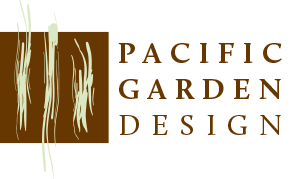In our previous post, we looked at three types of edging that are all installed as long strips anchored into a trench. This time we’ll look at a few options that provide a different look and functionality than the previous choices, all laid on the surface rather than buried. As with most things, the edging product that fits with one landscape design could be totally out of place or unworkable in another, so considering your needs and the attributes of each option is crucial.
Concrete Edging
Concrete edging, or curbing as it is sometimes called, is a popular choice in Spokane and Coeur D’Alene landscapes because it is well suited for our hilly geography. Concrete edging is formed in place, so the wet mix will conform to any terrain and bend around curves. Another reason for its popularity is the ease with which you can operate a mower around it. The wide, smooth surface of the concrete edging allows mower wheels to ride over the top, eliminating the need for string trimming or edging.
As with any concrete, however, the finished product is a solid mass. It can’t be moved in a redesign and can crack as the ground settles. Additionally, the wide, gray strips call attention to themselves and can easily overwhelm the landscape in small spaces. While the concrete can be tinted and stamped with a pattern to better blend into the landscape, concrete itself is already expensive. Add in the specialized equipment used to form the curb, pigment to tint the concrete, and labor to stamp a pattern, and concrete edging usually turns out to be a pricey option.
Paver and Stone Edging
Rather than using long, continuous strips of material, there is also the option to use concrete or natural stone pavers, cobbles, or similar objects to form the edging. The small segments can be easily placed around tight curves or straight lines on any terrain. The choice of product, however, can be customized to fit the character of the space, unlike any other edging option. Whether it’s weathered cobblestones, traditional bricks, or concrete pavers, the edging can truly be integrated into the design of the landscape. A rocky site can even make use of the rocks unearthed in construction for a cost-effective approach that grounds the landscape in its setting.
While paver and stone edging can be a unique look, it does require a lot of labor to achieve, which will account for a large part of the cost. Depending on the exact material, it may also be necessary to edge or line trim around the perimeter of the lawn after mowing. Some materials, such as smaller found rock, may be unsuitable for using around lawn areas and best used only to contain gravel paths and patios.
No Edging
Finally, there’s the option to have no edging at all. While it certainly takes more maintenance to achieve a clean look, omitting edging between landscape bed and lawn can still result in a great finished landscape. It works well on sloping sites that have few edging options available, in relaxed cottage gardens, in small yards with little edge to maintain, and in many other situations.
If that’s not enough information to help you make a decision, get in touch with us at Pacific Garden Design and we can help you design the landscape you’re looking for.





